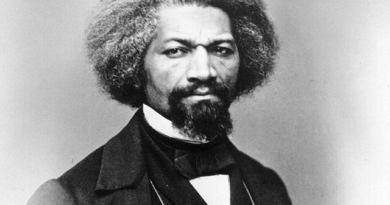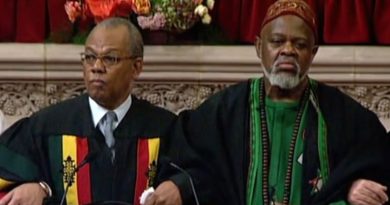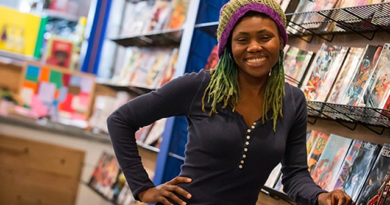Cultural Inspirations for the Clothing of Black Panther’s Wakanda by R.L. Witter
By R.L. Witter
Now that most of us have made at least one trip to Wakanda (okay, I’ve made three and will likely go again), we can finally discuss some of the fantastic sights and sounds we experienced in Marvel’s Black Panther movie. Beyond how gorgeous the cast is and the amazing technology depicted in Wakanda, I was mesmerized by the attention to detail regarding the Wakandan people and how director Ryan Coogler used inspiration from throughout The Continent to create these fictional African people. Let’s learn about the real-life cultural inspirations for some of the clothing, sounds, and accessories.
One character who seemed to draw my attention whenever he was on the screen was the River Tribe Elder, played by Isaach de Bankolé. He appeared in brightly colored suits and robes, with matching lip plates. The lip plates are most common in Mursi and Surma cultures in Ethiopia. While lip plates are now most common among tribal women, in the past African men wore lip plates as a rite of passage into manhood or a symbol of their status within the tribe — the bigger the better.
Angela Bassett was amazing as Queen Ramonda and her wardrobe was gorgeous! She most often wore a Zulu isicholo headdress, a tall, round hat with a flat top. Isicholos are traditionally worn by married Zulu women and traditionally sewn into the hair. The hair would be straightened, herbs would be applied, and the hat would be sewn into her hair so it could no longer be taken off and over a period of a few months would rot on her head. Her hair would then be washed and the procedure repeated. Today, the hats are no longer sewn into the hair, and they’re generally only worn on special occasions.
W’Kabi, played by Daniel Kaluuya, wore a Basotho blanket, worn traditionally by the Sotho people of the Kingdom of Lesotho. The layout of the design, the various symbols, the bold colour combinations and the characteristic pin-stripe make Basotho blankets unique. Originally, the stripe was a weaving fault, but it has become part of the design and now dictates how the blanket is worn. Traditionally, the pin-stripe runs vertically, symbolizing growth. In Basotho culture the corncob is a symbol of fertility and wealth, and is the most widely used motif; the more corn cobs, the more prestigious.
One feature of the uniforms worn by the all-woman Royal Guard, The Dora Milaje, is the usage of Ndebele neck rings from South Africa. In earlier times, Ndebele women wore copper and brass rings around their arms, legs and neck as symbols of faithfulness to their husbands. The rings, (called idzila), were only removed after a husband’s death and were believed to have strong ritual powers. Husbands used to provide their wives with rings; the richer the husband, the more rings the wife would wear. Today, it is no longer common practice to wear these rings permanently.
Wakanda’s River Elder was a striking character, based on the Himba women of Namibia. Himba women are known for adorning themselves with otjize, a paste made from red ochre, butter, and aromatics. They apply it each morning, much like western women use makeup, but otjize is applied to both hair and skin to give a distinct, red hue. The Himba have largely resisted westernization and mainly dress in leather from animal hides. They eat an almost exclusive diet of porridge made from either maize or millet, but on special occasions such as weddings, they will eat meat.
The wide-sleeved robe worn by Forest Whitaker’s Zuri is called an agbada. Worn throughout West Africa, the robes are called by many different names. While agbada is a Yoruban word, the robes are also called boubou, mbubb, babban riga, k’sa, or gandora. A woman’s version of the robe is called a m’boubou or kaftan.
Those scarves that wrapped around heads, faces, and necks often adorn the Tuareg people of North and West Africa and are called tagelmust. A tagelmust protects desert people from blowing sand and is often darkly colored with indigo powder, which sometimes transfers a blue hue to their skin. Tuareg men who were the scarves are known as Kel Tagelmust or “Men of the Veil.” How it’s wrapped and folded can tell clan and regional origin, and the darkness to which it is dyed (the darker the berry…) shows the wealth of the wearer.
And while many of us know kente cloth when we see it, we might not have recognized Lupita Nyong’o’s Nakia wearing it in the Korean casino scene. Black Panther costume designer, Ruth E. Carter, and her team designed the gorgeous green gown by starting with kente cloth, then extracting lines, hand painting the fabric, and adding Wakandan symbols.
So it seems the Motherland and her people were well represented in Black Panther and the people of Wakanda are a delightful and beautiful mélange of colors and cultures of The Continent. With more than $1 billion thus far in box office returns, the affinity for Wakanda is undeniable. So many people wore various African or African-inspired fashion to the movie, perhaps we’ll be seeing more vestments from the Motherland adorning black and brown bodies everywhere. I know I’ll be recycling my African print maxi skirt for a party in April and hopefully, many times thereafter. I plan to incorporate a little bit of Wakanda into my life for the foreseeable future.


